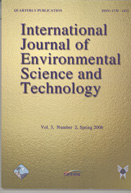
|
International Journal of Environment Science and Technology
Center for Environment and Energy Research and Studies (CEERS)
ISSN: 1735-1472
EISSN: 1735-1472
Vol. 7, No. 3, 2010, pp. 519-534
|
 Bioline Code: st10051
Bioline Code: st10051
Full paper language: English
Document type: Research Article
Document available free of charge
|
|
|
International Journal of Environment Science and Technology, Vol. 7, No. 3, 2010, pp. 519-534
| en |
Partitioning of major and trace inorganic contaminants in fly ash acid mine drainage derived solid residues
Gitari, W.M.; Leslie, F.P.; Key, D.L. & Okujeni, C.
Abstract
Acid mine drainage was reacted with coal fly ash over a 24 h reaction time and species removal trends evaluated. The evolving process water chemistry was modeled by the geochemical code PHREEQC using WATEQ4 database. Mineralogical analysis of the resulting solid residues was done by X-ray diffraction analysis. Selective sequential extraction was used to evaluate the transfer of species from both acid mine drainage and fly ash to less labile mineral phases that precipitated out. The quantity of fly ash, volume of acid mine drainage in the reaction mixture and reaction time dictated whether the final solution at a given contact time will have a dominant acidic or basic character. Inorganic species removal was dependent on the pH regime generated at a specific reaction time. Sulphate concentration was controlled by precipitation of gypsum, barite, celestite and adsorption on iron-oxy-hydroxides at pH > 5.5. Increase of pH in solution with contact time caused the removal of the metal ions mainly by precipitation, co-precipitation and adsorption. PHREEQC predicted precipitation of iron, aluminium, manganese-bearing phases at pH 5.53-9.12. An amorphous fraction was observed to be the most important in retention of the major and minor species at pH > 6.32. The carbonate fraction was observed to be an important retention pathway at pH 4-5 mainly due to initial local pockets of high alkalinity on surfaces of fly ash particles. Boron was observed to have a strong retention in the carbonate fraction.
Keywords
Acid mine drainage; Fly ash; Neutralization; Residue; Sequential extraction
|
| |
© Copyright 2010 - Center for Environment and Energy Research and Studies (CEERS)
Alternative site location: http://www.ijest.org
|
|
